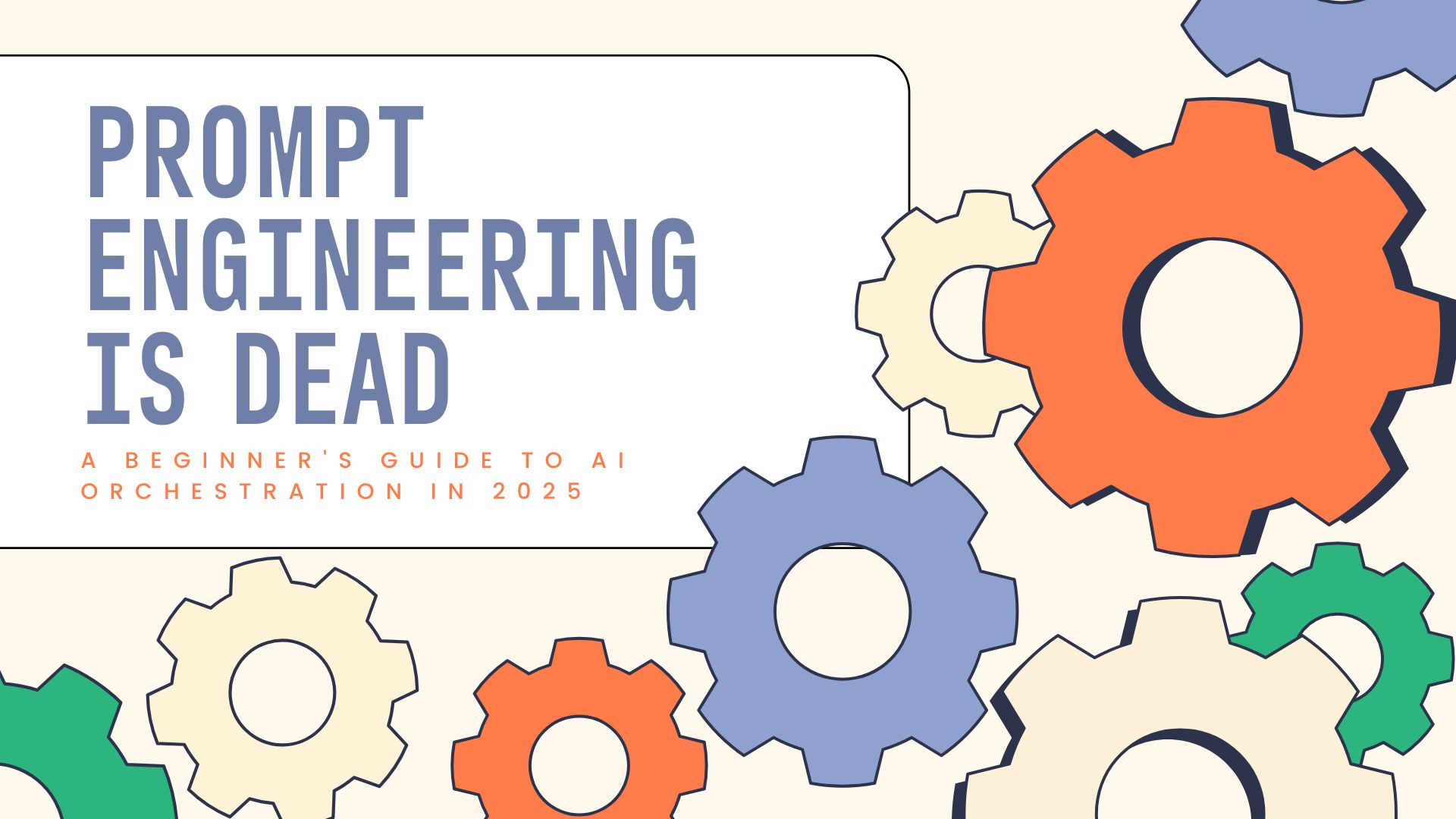Hello and welcome! If you’ve spent any time with artificial intelligence, you’ve probably heard the term “prompt engineering.” For a while, it seemed like the most important skill of the future—the art of writing the perfect command to get an AI to do exactly what you want. It was like learning a magic spell to command a powerful genie.
But here in 2025, the world of AI is moving at lightning speed. And while knowing how to talk to an AI is still useful, the idea of just writing single prompts is starting to feel a bit like using a flip phone in an age of super-smart devices.
So, is prompt engineering truly dead?
Well, not in the way a dinosaur is dead. It’s more like how learning to ride a horse is for transportation. It’s a valuable skill, but most of us now rely on cars, trains, and planes to get around. Prompt engineering is evolving into something much bigger, more powerful, and way more exciting: AI Orchestration.
Think of it like this: prompt engineering is learning to talk to one musician. AI orchestration is learning to conduct an entire orchestra.
In this guide, we’ll explore this incredible shift. You’ll learn what AI orchestration is, why it’s the next big thing, and how you can start thinking like an AI conductor, even if you’re a complete beginner.
The Evolution of Prompt Engineering: From Art to Automation
Just a few years ago, between 2020 and 2024, prompt engineering was the talk of the town. We all went through a rapid learning process.
First, we started with simple prompts, like asking an AI, “Write a poem about a robot who is sad.” The results were cool, but often generic.
Then, we got smarter. We learned to fine-tune our requests, adding details and context. We used techniques like “few-shot learning,” which is like showing an AI a few examples of what you want before asking it to create something new. For instance, you’d show it three examples of a good marketing email, and then say, “Now, write one for my new product.”
We even developed complex methods like “chain-of-thought” prompting, where we’d ask the AI to “show its work” and think step-by-step to solve harder problems.
But even with these clever tricks, we started to see some cracks in the foundation.
- It Was Hard to Scale: Imagine you’re running a business. You can’t have someone manually typing perfect, multi-step prompts for every single task, all day long. It’s just too slow.
- It Was Brittle: Sometimes, changing a single word in a prompt could give you a completely different—and often useless—result. It was like a secret password that had to be perfect every time.
- It Wasn’t Adaptable: A good prompt for today might not work tomorrow if the AI model gets updated or the situation changes. The prompts were static, but the world is dynamic.
It became clear that we needed a better way. We needed to automate the process of guiding AIs. This led to the development of tools and frameworks like LangChain, which helped connect different AI prompts together in a chain. This was the first hint of what was to come—the first step towards building an entire team of AIs.
The Rise of AI Orchestration: Why It Matters in 2025
This brings us to today. So, what exactly is AI orchestration?
AI orchestration is the coordination and management of multiple AI models, tools, and systems to automate complex, multi-step tasks.
Instead of you giving a single instruction to a single AI, an orchestrator acts as a project manager for a whole team of specialized AIs. It breaks down a big goal into smaller tasks and assigns each task to the best AI for the job.
As companies and even individuals start using lots of different AIs—one for writing, one for analyzing data, one for scheduling—we need a way to make them talk to each other. Without a conductor, you just have a room full of talented musicians playing different songs. It’s chaos. With an orchestrator, you get a beautiful symphony.
The experts agree. Tech research firm Gartner predicts that by 2028, 70% of large companies will use AI orchestration to make their systems work together.
The benefits are huge:
- Supercharged Efficiency: Complex processes, like setting up a new employee with a laptop, payroll, and training, can be fully automated.
- Better Data, Better Actions: The orchestrator can give your AIs access to the right data (like customer history or sales numbers) so they can make smart decisions and take action.
- Less Mess: It prevents companies from having ten different AIs that all do the same thing, saving time and money.
- Trust and Safety: Orchestration helps ensure that all the AIs are following the rules, keeping data secure, and working as expected.
- Flexibility: A good orchestration system can easily swap out one AI model for another, newer one without having to rebuild everything from scratch.
Key Concepts in AI Orchestration
To understand orchestration, it helps to think of it like running a modern company. Here are the key players:
- AI Agents: These are the specialized “employees.” An agent is an AI program designed to do a specific job. You might have a “Calendar Agent” that only handles scheduling, a “Research Agent” that scours the web, and a “Sales Agent” that talks to customers. They are autonomous, meaning they can work on their own once given a goal.
- Large Language Models (LLMs): This is the core “brainpower” of the company. It’s the powerful, general-purpose AI (like GPT-4, Claude 3, or Gemini) that the agents consult when they need to reason, write, or solve a tricky problem.
- Data Pipelines: These are the communication systems of the office—the hallways, email servers, and messenger apps. They ensure that information flows cleanly and quickly between all the different agents and systems.
- Integration Platforms: This is the “office building” itself. It’s the software that connects everything together. It’s the central hub where the agents get their assignments and report back on their progress.
- Workflow Automation: This is the “project plan.” It’s the sequence of tasks you design for the agents to complete to achieve a larger goal.
AI Orchestration in Practice: Real-World Examples
This might sound abstract, so let’s look at how it works in real life.
Human Resources (HR): Imagine a new employee, Maria, joins a company. Instead of filling out 20 different forms, she just has a quick chat with an “Onboarding Bot.” Behind the scenes, the AI Orchestrator kicks into gear. It tells the IT Agent to order a laptop, the Payroll Agent to set up her salary, the Benefits Agent to enroll her in health insurance, and the Calendar Agent to schedule her orientation meetings. Maria has one simple conversation, and the AI team does the rest.
Customer Service: You have a problem with your internet service. You start a chat on the company’s website. The first AI agent, a Triage Bot, understands your problem. It realizes this is a technical issue and passes the case to the Diagnostics Agent. This AI runs tests on your connection remotely. If it can’t fix the problem, the orchestrator seamlessly transfers the entire conversation history to a human agent, who now has all the information they need to help you.
Sales and Marketing: An AI orchestrator can create incredibly personalized marketing campaigns. It could tell a Data Agent to find potential customers, a Writing Agent to draft personalized emails for each of them, an Image Agent to create a custom graphic for the email, and a Scheduling Agent to send it at the perfect time.
Getting Started with AI Orchestration: Your First Steps
Feeling inspired? You don’t have to be a giant corporation to start thinking about orchestration. Here’s how you can begin.
Tools of the Trade: Big companies use powerful platforms like IBM watsonx Orchestrate, Adobe Experience Platform, and Workato. These are like industrial-grade command centers for AI. For those who like to build things themselves, open-source frameworks like LangChain provide the “LEGO bricks” to connect different AI models and create your own agentic systems.
Practical Steps for Beginners:
- Find a Boring Task: What’s a repetitive, multi-step task you do on your computer? Maybe it’s organizing your files, summarizing meeting notes and emailing them, or planning your weekly meals. These are perfect candidates for orchestration.
- Start Small: Don’t try to automate your entire life on day one. Pick one simple workflow. For example: “When I save a meeting transcript to a folder, automatically create a summary and save it as a new document.”
- Use What You Have: Tools you already use, like Voice Flow or Make.com, are basically beginner-friendly orchestration platforms. They let you connect different apps (like Gmail, Google Drive, and Slack) in a workflow. Now, they are adding AI steps, allowing you to build simple orchestrations without any code.
The Future: Beyond Prompts and Towards Autonomous Agents
This shift from prompting to orchestration is more than just a new tech trend; it’s changing our relationship with technology. We are moving away from a world where we give AI direct commands and towards a world where we give it high-level goals.
Our role is evolving from being the worker to being the manager. We are becoming the creative directors and supervisors for teams of highly capable AI agents. We set the vision, and they handle the execution.
Of course, this powerful future comes with important responsibilities. We need to ensure these autonomous systems are built safely and ethically. We must think carefully about control, transparency, and fairness to make sure our AI teams are working for the benefit of everyone.
Conclusion
So, let’s go back to our original question: is prompt engineering dead? No, but it has been promoted. It’s no longer the entire job; it’s just one small part of a much bigger, more strategic role.
Understanding how to communicate a goal clearly is still important. But the real skill of the future is knowing how to design systems, manage teams of AIs, and orchestrate complex workflows to solve problems we couldn’t tackle before.
The future of AI isn’t about finding the perfect magic words. It’s about becoming the conductor of your own digital orchestra. The best part is, the music is just getting started, and you have a front-row seat. Start looking for those boring tasks in your life, and imagine how an AI team could do them for you. The tools are here, and the possibilities are endless.


